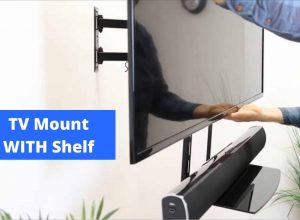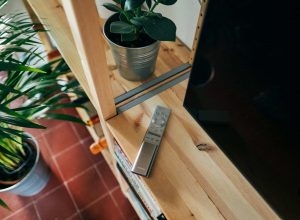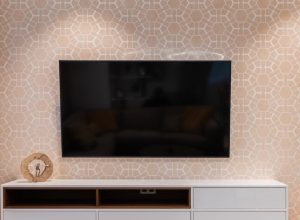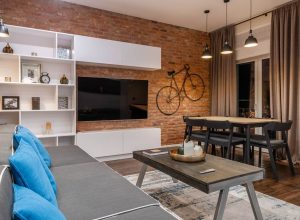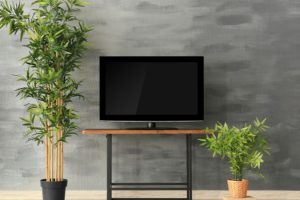So you’ve bought a new television and a premium, sturdy wall mount for it to install onto your wall.
One problem that you can run into is that you buy the wall mount and TV, only to find out that your wall studs are too far apart.
What do you do now? Is it just impossible for you to mount your TV on the wall now
Quick summary
In this post, we will discuss what options you have to mount your TV on the wall if your wall studs are too far apart.
We will list many options so we advise that you go through the entire post until you find a method that is most suitable for your needs.
So without further ado, let’s get into it.
Identifying the Wall Studs with a Stud Finder

Image Courtesy: Reddit
Before we actually start exploring our options for when the studs are too far apart, you must first identify if that is even the case.
You can find out the locations of studs in your wall through the use of a stud finder. You can easily buy one off of Amazon or from your local hardware store.
If you have a stud finder, all you have to do is turn it on and slowly run it across the spot where you intend to install your TV wall mount.
The stud finder will either give you a notification on its screen or produce a beeping sound when it finds a stud in your wall. The type of indicator you get will depend on the make and model of the stud finder.
If you can’t or don’t want to get a stud finder, you don’t have to worry as there are other ways to find studs in your wall too.
The most classic method is the knocking technique. Just knock at different spots on the wall where you intend to mount your TV.
If you hear a hollow sound when you knock, that means that there is no stud at that spot. However, if you hear a denser, fuller sound, then that means there is a stud behind your wall.
TV mounts typically need two or three studs in order to be properly installed onto your wall.
When you find a single stud in your wall, you should check whether it has a corresponding stud near it at the standard distance. The typical standard stud spacings that most wall mounts support are either 16 inches or 24 inches.
If you have standard stud spacing, it’s fairly easy to find a wall mount for it. However, if you have irregular stud spacing or if you just bought a wall mount that supports the incorrect spacing, then you might be in trouble.
Luckily, there are some options you can explore if your studs are too far apart.
Did You Intend to Install the TV Mount Over a Fireplace?

If you were originally intending to mount your TV over a fireplace but found that the studs were too far apart, we highly recommend thinking about a different spot.
If you can find some other spot in your house that is on a regular wall, we would highly recommend analyzing it to see if it works.
Use a stud finder or the knocking technique to check whether the studs are at a suitable spacing at that second location you choose for your TV.
There’s a high chance you may find studs that are at a suitable spacing that allows your wall mount to be easily installed.
Furthermore, you don’t want to install your TV over a fireplace in most cases anyway.
This is because your TV gets mounted too high. This can cause neck strains and just an overall unpleasurable viewing experience.
Option 1: Construct a Plywood Mounting Plate
If the other locations in your house also have studs that are too far apart, then you’ll have to figure out some other way to mount your TV to the wall.
The first option you can consider is to construct a Plywood mounting plate.
This plate will be a suitable piece of ¾-inch thick Plywood that will span across the studs in your wall.
Once you’ve attached the Plywood to the studs, you can then attach the TV mount to the Plywood mounting plate.
Please note that this method is only safe if your TV is lightweight (no more than 55 pounds).
If you have a heavier TV, then we recommend using one of the other methods.
Here’s how you do it:
Step 1: Get a suitable piece of ¾-inch thick Plywood from your local hardware store.
Step 2: Cut it down from the sides so that it will be concealed by your TV once it gets installed.
Step 3: Paint the Plywood so that it matches the color of the paint on your wall. You want it to blend in and not look like a cheap fix-up job.
Step 4: Secure the Plywood to the studs in your wall using strong lag bolts.
The Plywood should ideally attach to at least two studs. If you can attach it to more, that would be even better.
While using wood screws is also a popular option, it can be slightly unsafe. This is because face screwing wood screws into the Plywood can prevent the wood from naturally expanding and contracting.
This can then cause the screws inside of it to loosen over time.
Hence, that’s why we recommend that you use lag bolts rather than wood screws and use a power drill to properly fasten them.
Step 5: Install your TV mount onto the Plywood mounting plate. If you can, you should try to get the screws all the way through the Plywood and into the wall for a more secure grip.
Option 2: Construct a Wooden or Metal Bar Mount
This method is fairly similar to option 1 but instead, you can use 2×4 perforated Steel bars to install the TV mount and TV itself.
Here’s how:
Step 1: Buy 2×4 perforated Steel bars and paint them using spray paint so that they match the paint on your wall.
Wait for the paint to dry before installing the Steel bars.
Step 2: Use a stud finder or the knocking technique to once again identify the locations of the studs in your wall.
It can be a good idea to mark the locations using a pencil or marker. Don’t worry about it looking ugly since the marks will be covered by screws or your TV anyway.
Step 3: Hold a single perforated Steel bar against the wall. We highly advise that you use a level at this stage to ensure that the bar is held up straight.
Use a pencil or a marker to mark the holes needed to drill it into the two studs.
Similar to option 1, the bars should be attached to at least two studs. However, if you can attach it to more studs without it being obtrusive, you should do so.
Step 4: Use a high-impact drill to make holes for the bar to be installed.
Step 5: Hold up the second bar right underneath the holes you made for the first one. The distance between them depends on the construction of your TV mount.
Of course, use a level at this stage as well to ensure both bars will be installed parallel to each other.
Step 6: Use your drill to install both Steel bars into their marked holes.
Step 7: Install the TV mount onto the Steel bars.
Option 3: Mount Your TV in a Corner

This may seem like an odd one but mounting your TV in a corner can actually have a ton of benefits that many people don’t think about.
Firstly, it saves space and leaves your walls open to hanging other things such as photographs, posters, paintings, etc.
Furthermore, it makes the process much easier since the corners of most houses typically have several wall studs.
The process for mounting is pretty much the same if you were mounting a TV into a regular wall.
Use a stud finder or the knocking technique to identify the studs in the wall first.
Next, hold the mounting bracket up to the corner and mark the holes you intend to make with the drill for installation.
Use your drill to make the appropriate holes and then use wall bolts to securely attach the TV mount to your wall.
Important note: Mounting your TV in a corner may not be the most suitable option for you if you intend to have a soundbar underneath it.
This is because you would have to place a soundbar on a small corner table which would look and be very clunky.
Option 4: Purchase a New Mount

This is simple enough. If you find that the mount you have purchased is not compatible with the wood studs or metal studs you have on your wall, you can just return it.
Most manufacturers have a return policy and if you return the product to them within a few days of purchase, you will most likely get a full refund.
With that full refund, you can then purchase a mount or TV bracket that is appropriate for your particular stud spacing.
Naturally, it’s a good idea to identify your stud spacing before you go out to buy another mount.
Use your stud finder or the knocking technique to identify several studs in your wall. Mark the individual locations for each stud with a pencil or something similar. Next, use your tape measure to measure the distances between them.
You have now found your stud spacing.
Now, you can browse the market to look for a wall mount that is specifically designed for the stud spacing that you have.
Quick tip: If you are unable to find a mount that suits your particular stud spacing, there’s no need to be discouraged.
You can find a ton of options for TV mounts in the market that attaches to the wall by using only a single stud or no studs at all.
They are called single-stud wall mounts and no-stud wall mounts respectively.
How High Should I Mount My TV?

Image Courtesy: Reddit
The general rule of thumb is that you should not have to bend your neck more than 30 degrees to watch TV.
There are several factors you must take into account to achieve this goal:
- The size of the TV
- How much space do you have in your room
- The TV’s height from the floor
Naturally, the higher you mount your TV, the farther away you’ll have to sit from it. Additionally, the bigger your TV is, the farther you’ll have to sit from it as well.
Sometimes, you may not have that much space in your room that you can be at a suitable distance from your television for a pleasurable viewing experience.
In this case, we recommend mounting your TV at a lower height than you normally would.
The goal is for the center of the TV to be equal to your eye level. For most humans, this is 42 inches from the floor.
Hence, in most cases, the center of your TV needs to be 42 inches from the floor.
Wrapping Things Up…
As you can see, having wall studs that are too far apart is not the end of the world.
You can easily find other methods and solutions that can enable you to easily install a mount onto your wall even if the studs are widely spaced.
If you have any questions regarding any of the methods described above, please reach out to us in the comments section below.
Adam F.
A/V and Home Theater Expert that focuses on providing clear as well as concise reviews for anything and everything Audio Visual. From TV's, TV Mounts, Soundbars, and Wiring, my focus is to provide expertise in everything Audio Visual focused.



